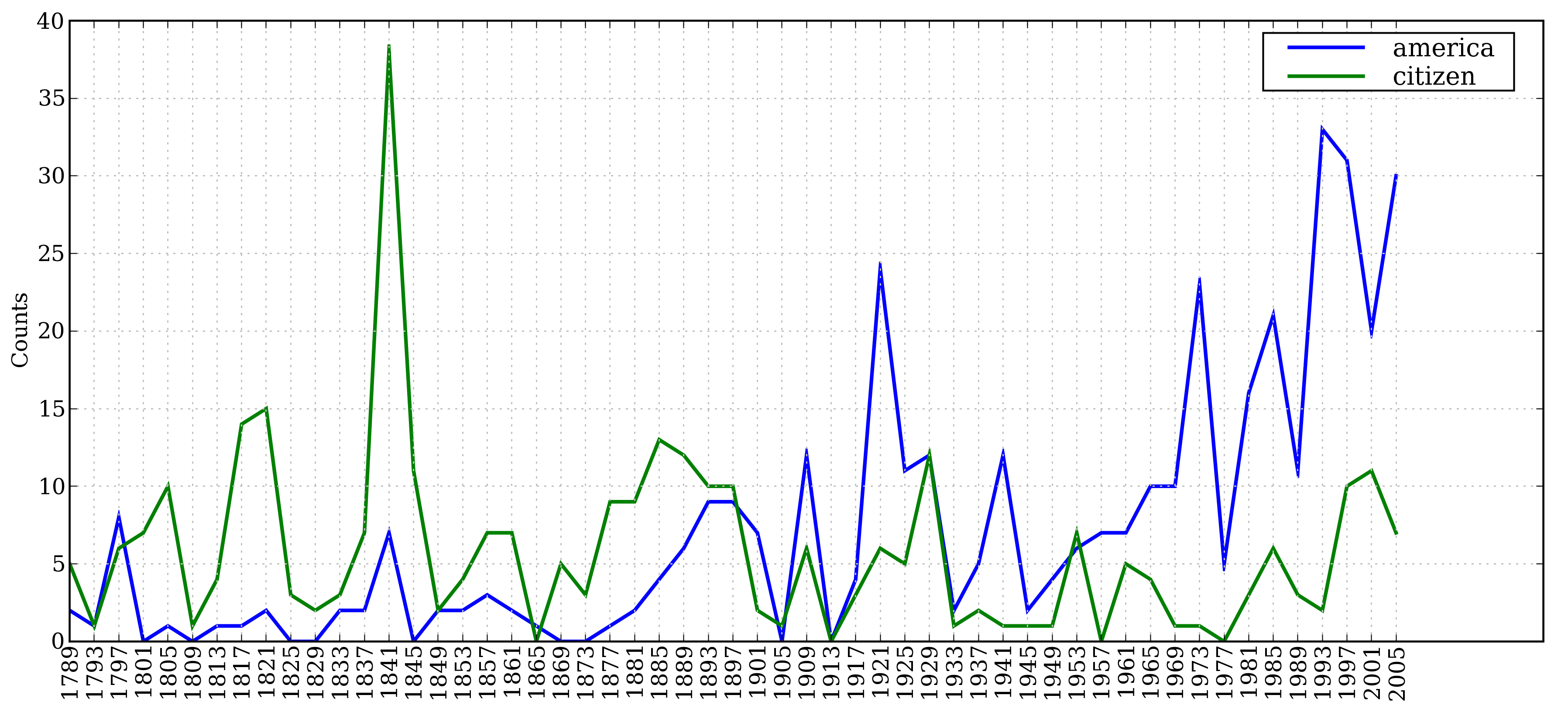用Python进行自然语言处理-2. Accessing Text Corpora and Lexical Resources
来源:互联网 发布:python 答题系统 编辑:程序博客网 时间:2024/05/29 17:20
1. 处理文本语料库
1.1 古腾堡语料库
这是一个电子书语料库,目前提供49,000本免费电子书。
我们可以看看nltk里集成了多少电子书:
>>> import nltk>>> nltk.corpus.gutenberg.fileids()['austen-emma.txt', 'austen-persuasion.txt', 'austen-sense.txt', 'bible-kjv.txt','blake-poems.txt', 'bryant-stories.txt', 'burgess-busterbrown.txt','carroll-alice.txt', 'chesterton-ball.txt', 'chesterton-brown.txt','chesterton-thursday.txt', 'edgeworth-parents.txt', 'melville-moby_dick.txt','milton-paradise.txt', 'shakespeare-caesar.txt', 'shakespeare-hamlet.txt','shakespeare-macbeth.txt', 'whitman-leaves.txt']我们可以用处理text1…text10的方法去处理。包括len、concordance等等。
我们还可以用raw方法获得所有字符,用words方法获得所有单词,用sents方法获得所有句子。进而可以计算平均词长、平均句长、用词多样性。
>>> for fileid in gutenberg.fileids():... num_chars = len(gutenberg.raw(fileid)) [1]... num_words = len(gutenberg.words(fileid))... num_sents = len(gutenberg.sents(fileid))... num_vocab = len(set(w.lower() for w in gutenberg.words(fileid)))... print(round(num_chars/num_words), round(num_words/num_sents), round(num_words/num_vocab), fileid)...5 25 26 austen-emma.txt5 26 17 austen-persuasion.txt5 28 22 austen-sense.txt4 34 79 bible-kjv.txt5 19 5 blake-poems.txt4 19 14 bryant-stories.txt4 18 12 burgess-busterbrown.txt4 20 13 carroll-alice.txt5 20 12 chesterton-ball.txt5 23 11 chesterton-brown.txt5 18 11 chesterton-thursday.txt4 21 25 edgeworth-parents.txt5 26 15 melville-moby_dick.txt5 52 11 milton-paradise.txt4 12 9 shakespeare-caesar.txt4 12 8 shakespeare-hamlet.txt4 12 7 shakespeare-macbeth.txt5 36 12 whitman-leaves.txt1.2 网络聊天语料库
从略
1.3 布朗语料库
这是一个分类语料库:
可以用categories方法获得所有分类:
>>> from nltk.corpus import brown>>> brown.categories()['adventure', 'belles_lettres', 'editorial', 'fiction', 'government', 'hobbies','humor', 'learned', 'lore', 'mystery', 'news', 'religion', 'reviews', 'romance','science_fiction']>>> brown.words(categories='news')['The', 'Fulton', 'County', 'Grand', 'Jury', 'said', ...]>>> brown.words(fileids=['cg22'])['Does', 'our', 'society', 'have', 'a', 'runaway', ',', ...]>>> brown.sents(categories=['news', 'editorial', 'reviews'])[['The', 'Fulton', 'County'...], ['The', 'jury', 'further'...], ...]利用布朗语料库我们可以研究不同文体之间的风格差异。比如,我们可以比较不同文体的情态动词的差异,这里用到了tabulate方法制作表格,也用到了条件概率分布方法ConditionalFreqDist获得不同文体的概率分布:
>>> cfd = nltk.ConditionalFreqDist(... (genre, word)... for genre in brown.categories()... for word in brown.words(categories=genre))>>> genres = ['news', 'religion', 'hobbies', 'science_fiction', 'romance', 'humor']>>> modals = ['can', 'could', 'may', 'might', 'must', 'will']>>> cfd.tabulate(conditions=genres, samples=modals) can could may might must will news 93 86 66 38 50 389 religion 82 59 78 12 54 71 hobbies 268 58 131 22 83 264science_fiction 16 49 4 12 8 16 romance 74 193 11 51 45 43 humor 16 30 8 8 9 131.4 路透社语料库
方法同布朗语料库
1.5 总统就职演讲语料库
>>> from nltk.corpus import inaugural>>> inaugural.fileids()['1789-Washington.txt', '1793-Washington.txt', '1797-Adams.txt', ...]>>> [fileid[:4] for fileid in inaugural.fileids()]['1789', '1793', '1797', '1801', '1805', '1809', '1813', '1817', '1821', ...]根据文件名以“年份-总统名”命名的特点,我们可以计算不同时期,某些词的频度分布:
>>> cfd = nltk.ConditionalFreqDist(... (target, fileid[:4])... for fileid in inaugural.fileids()... for w in inaugural.words(fileid)... for target in ['america', 'citizen']... if w.lower().startswith(target)) [1]>>> cfd.plot()
0 0
- 用Python进行自然语言处理-2. Accessing Text Corpora and Lexical Resources
- 用Python进行自然语言处理-1. Language Processing and Python
- 用python进行自然语言处理
- 用python进行自然语言处理
- 用Python进行自然语言处理-笔记
- Python进行自然语言处理pdf
- 推荐《用Python进行自然语言处理》中文翻译-NLTK配套书
- Python 自然语言处理 二: 用ngrams 进行 语言种类识别
- 用python进行自然语言处理 第一章练习题答案
- (初学者)用Python进行自然语言处理笔记一
- (初学者)用python进行自然语言处理笔记二
- 用pattern进行自然语言处理
- python+spaCy 进行简易自然语言处理
- Accessing Resources
- Accessing Resources
- Accessing Resources
- Corpora and Vector Spaces
- 用NLTK进行自然语言处理的项目
- hdu杭电1002 Train Problem I【栈】
- Openmpi安装
- JVM 进阶 一
- Container With Most Water
- Realflow制作融化特效
- 用Python进行自然语言处理-2. Accessing Text Corpora and Lexical Resources
- 关于python在cmd中输出中文乱码的问题
- 原地随机排列数组
- lsdk无线驱动与管理层的接口
- 【HDOJ 5288】OO’s Sequence
- ARM 中的内存分类
- 挺好的
- HDOJ题目4705 Y(简单树形DP+数学)
- mysql提示 Lock wait timeout exceeded解决办法


